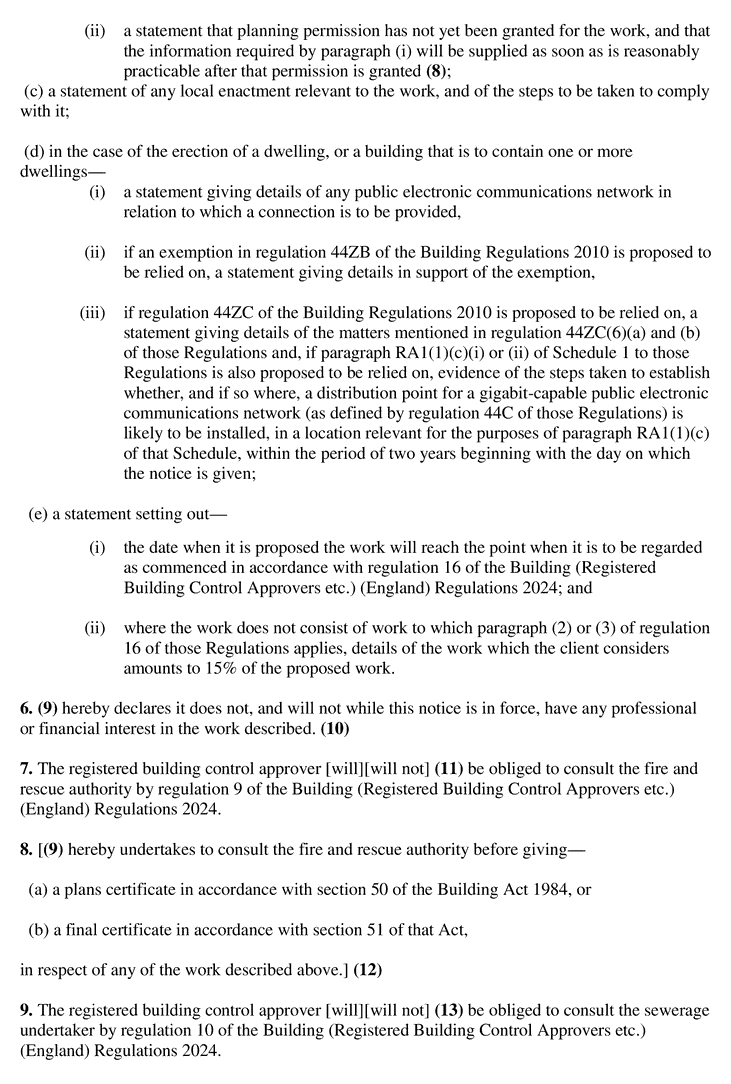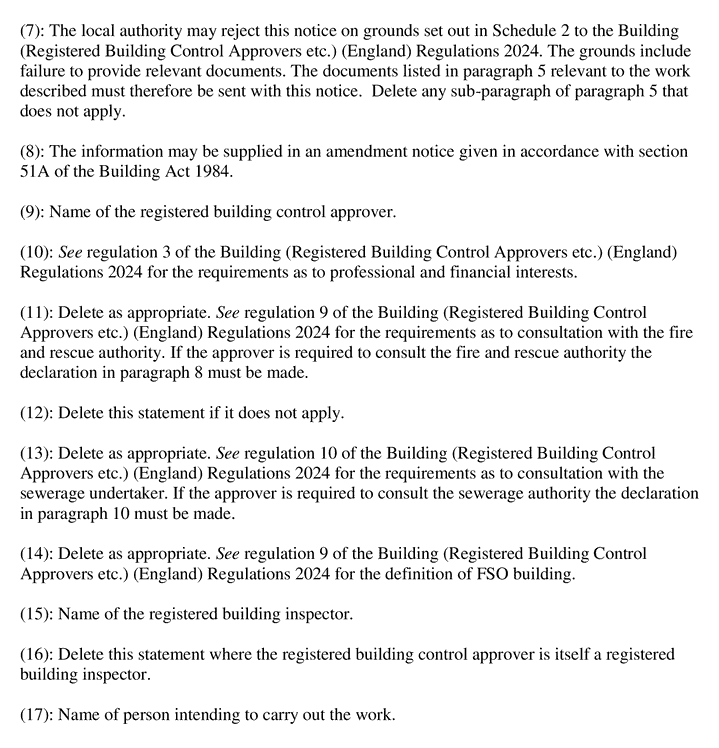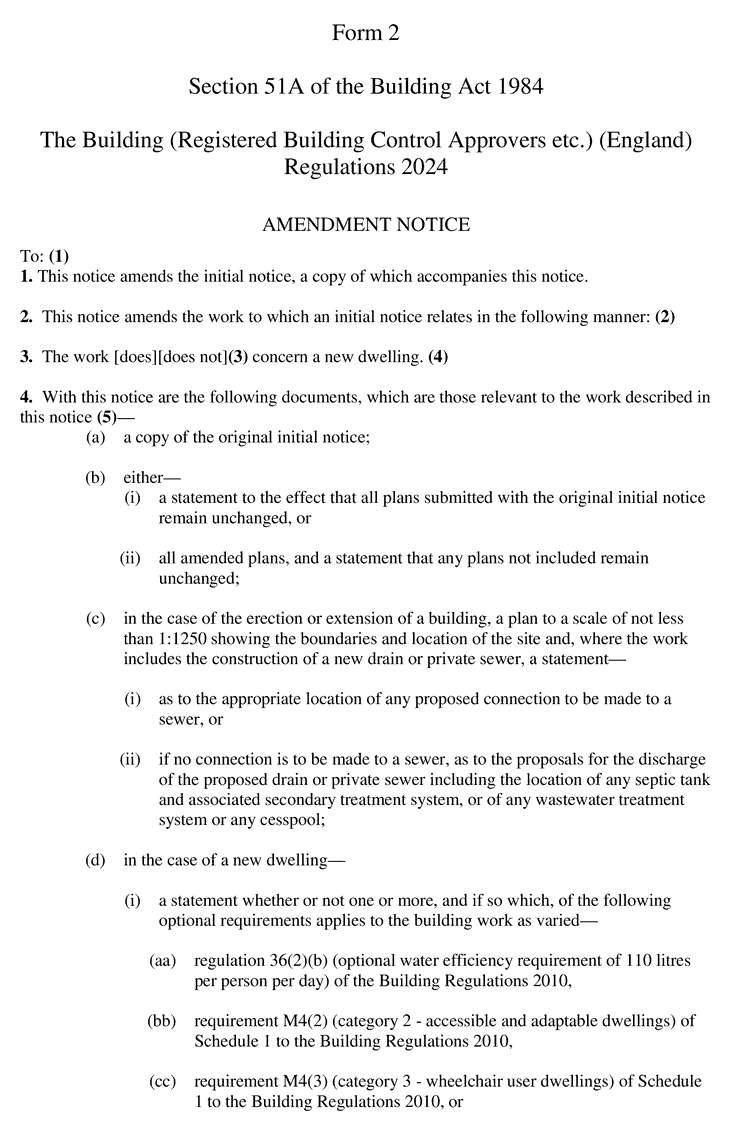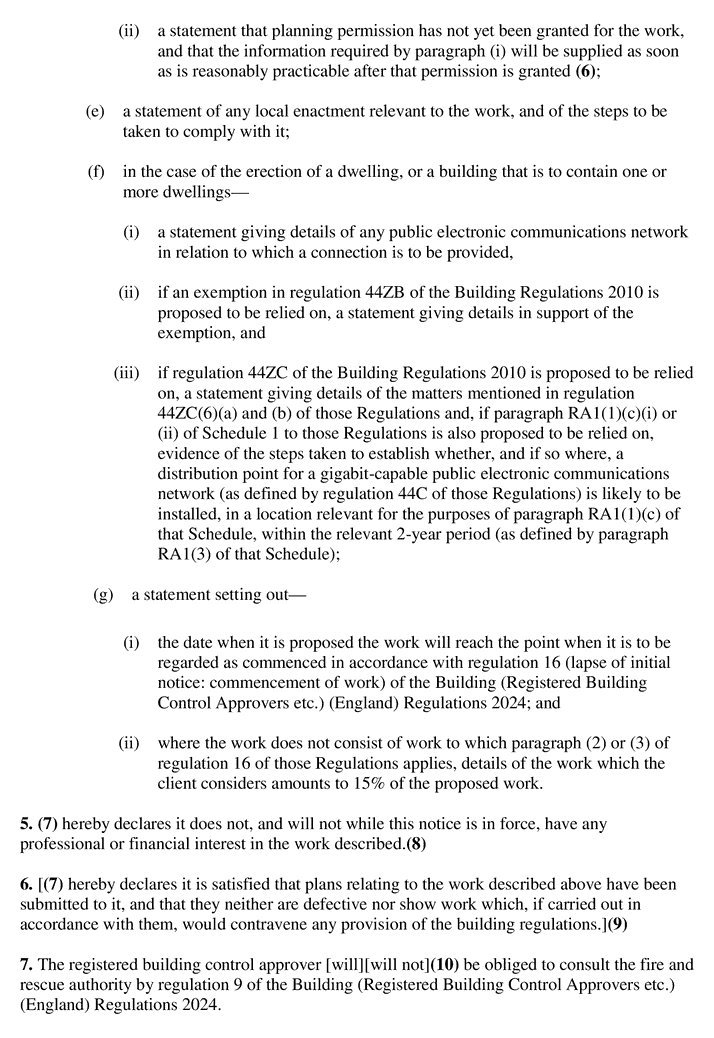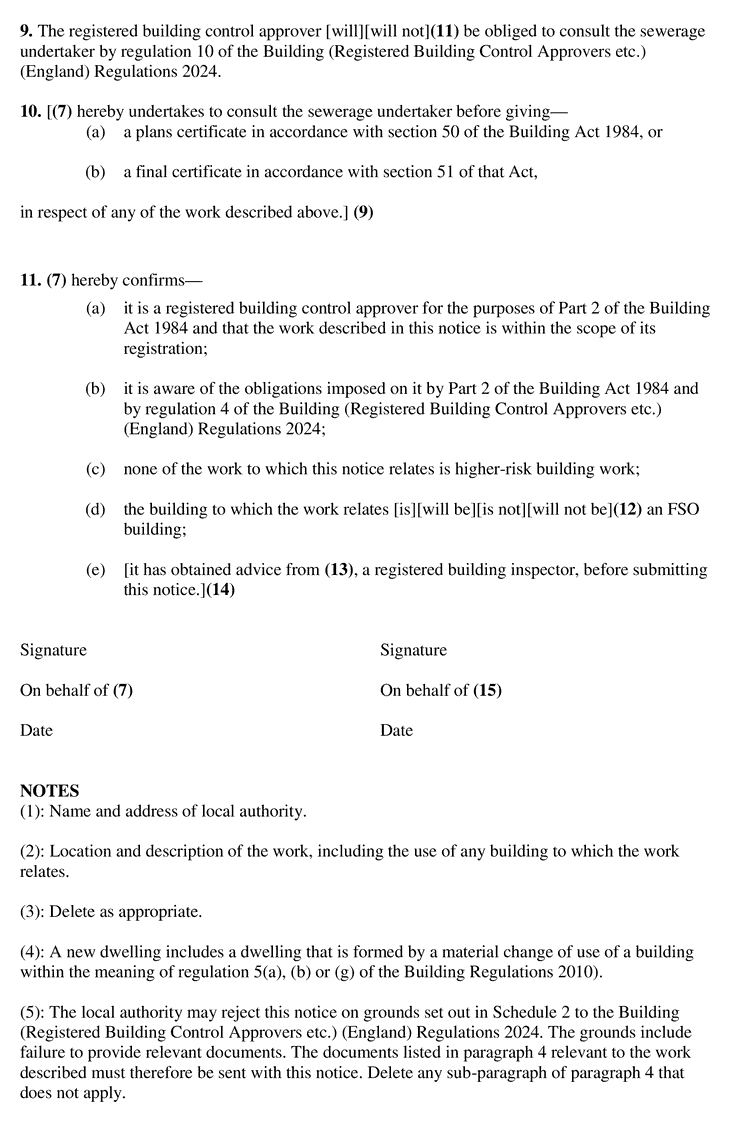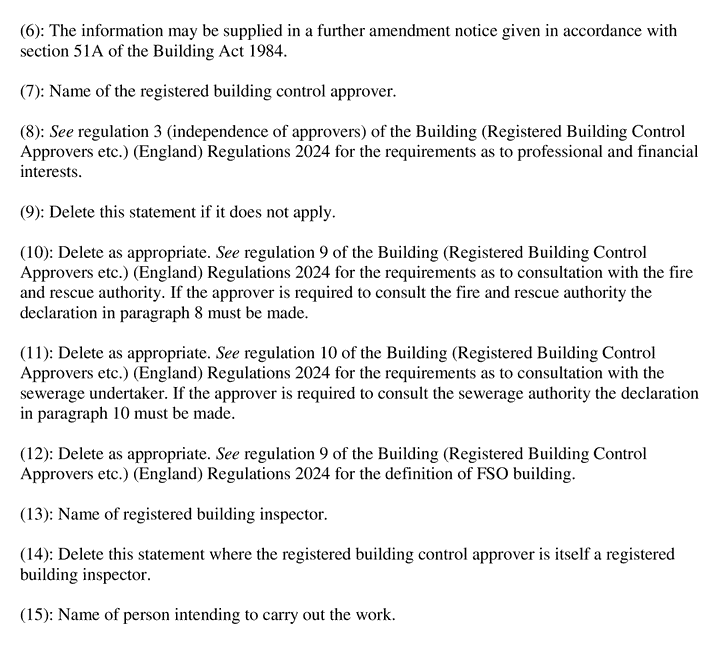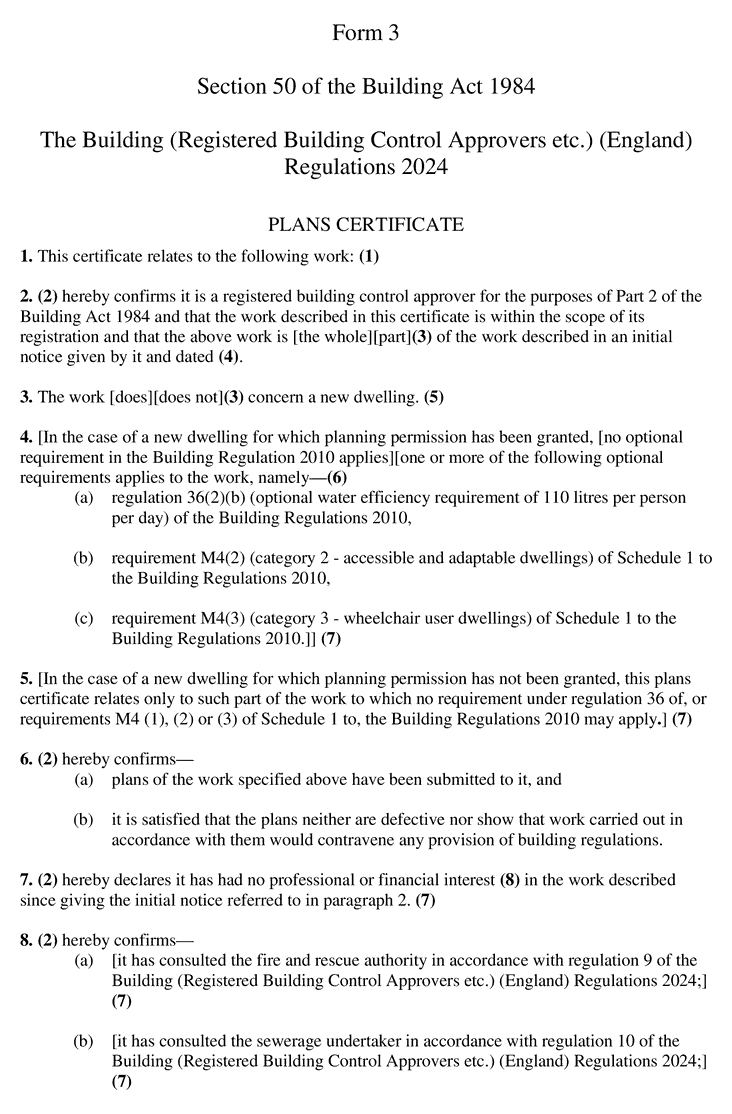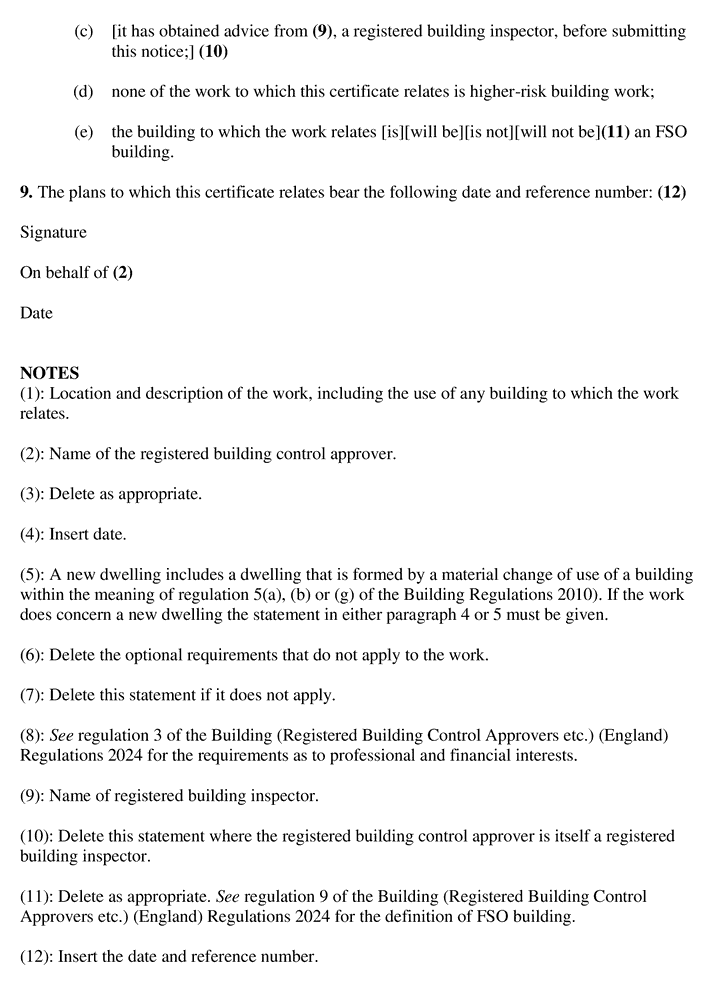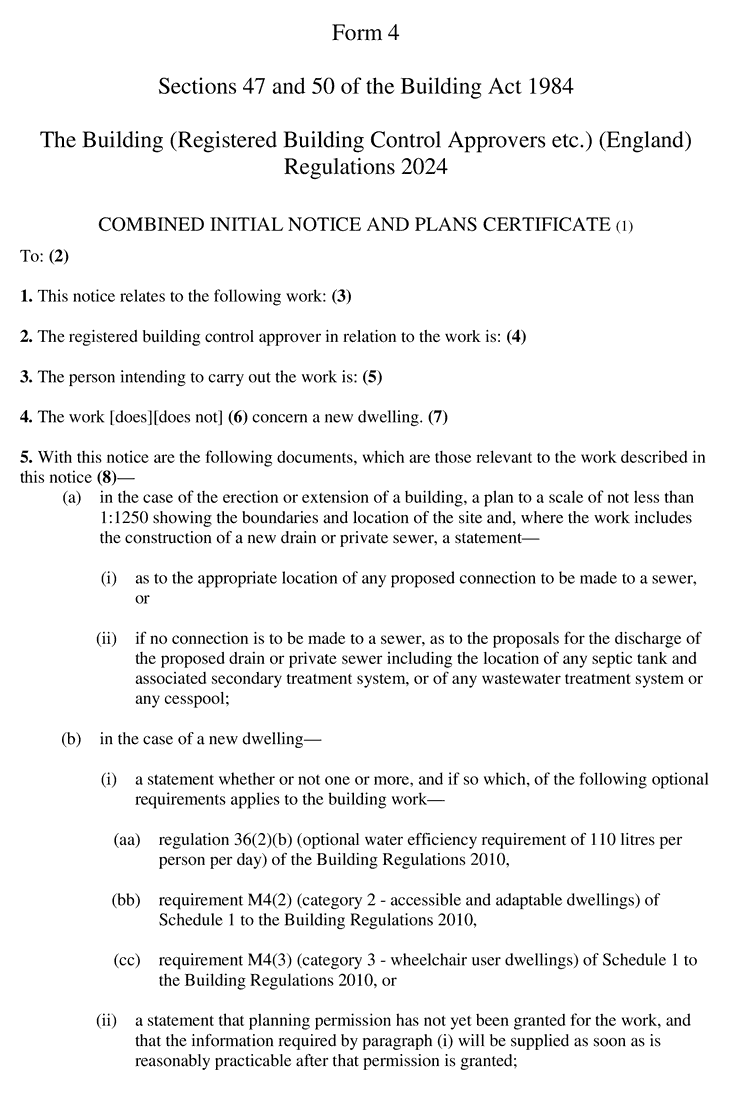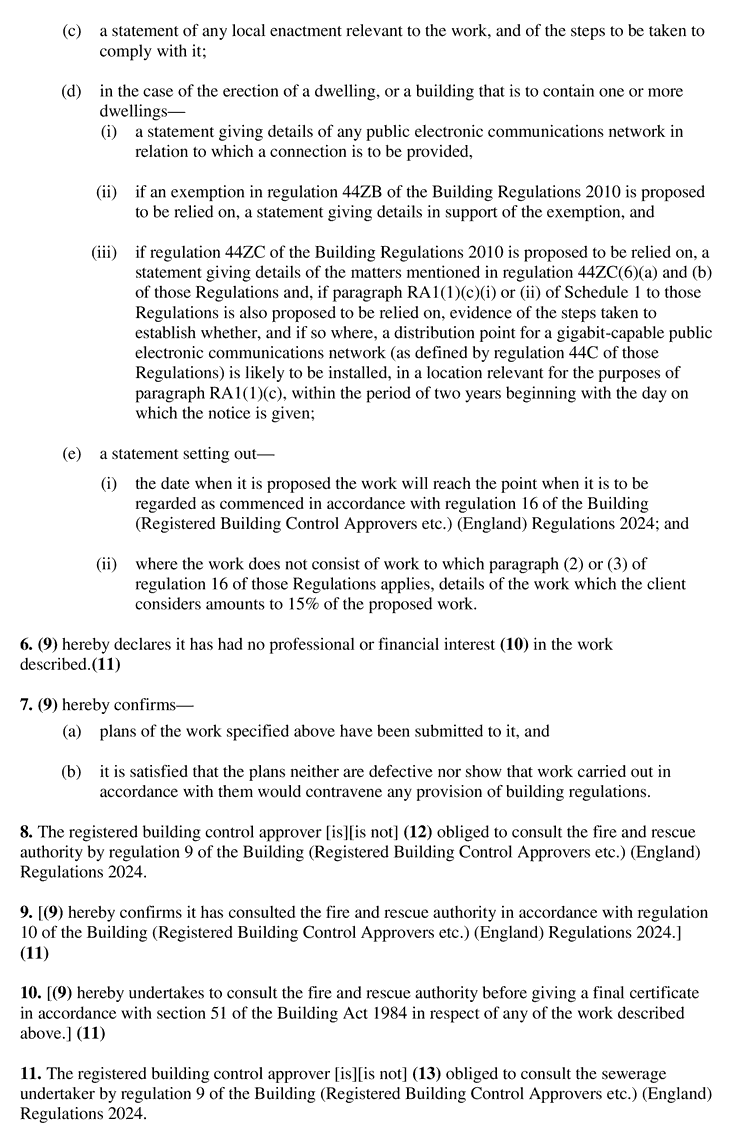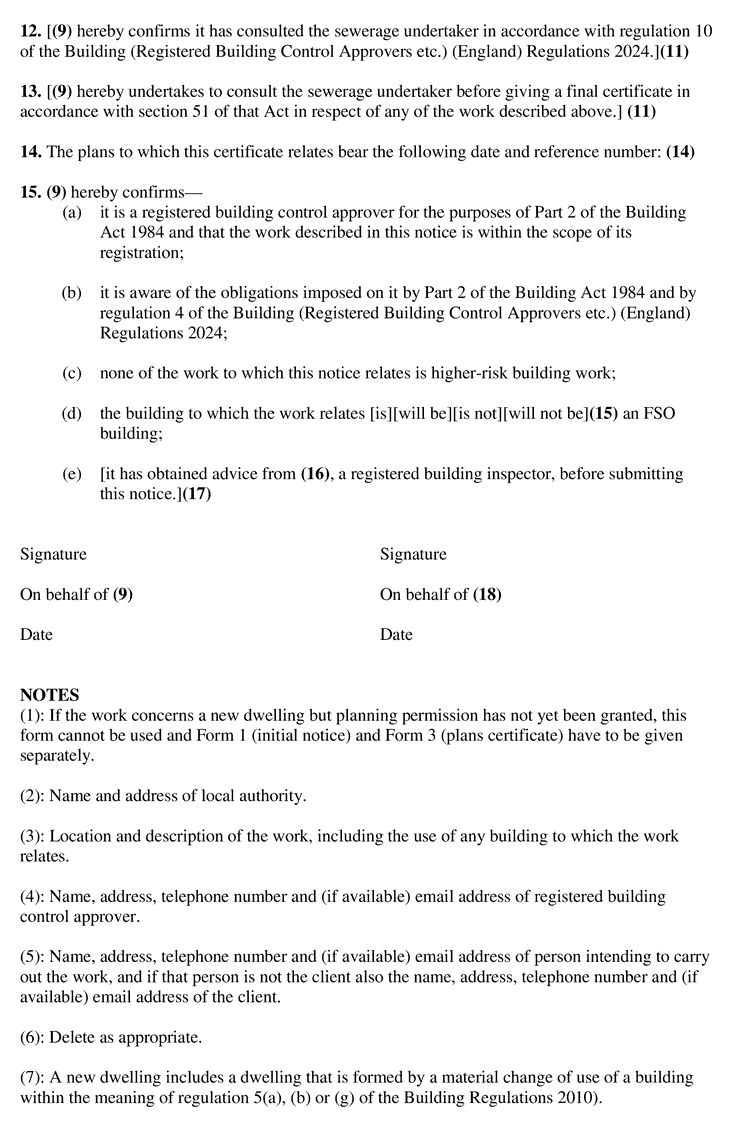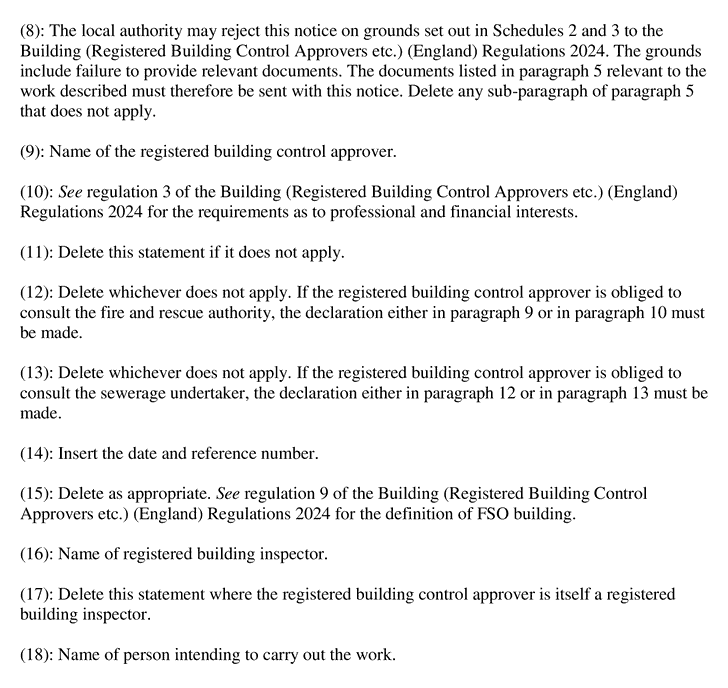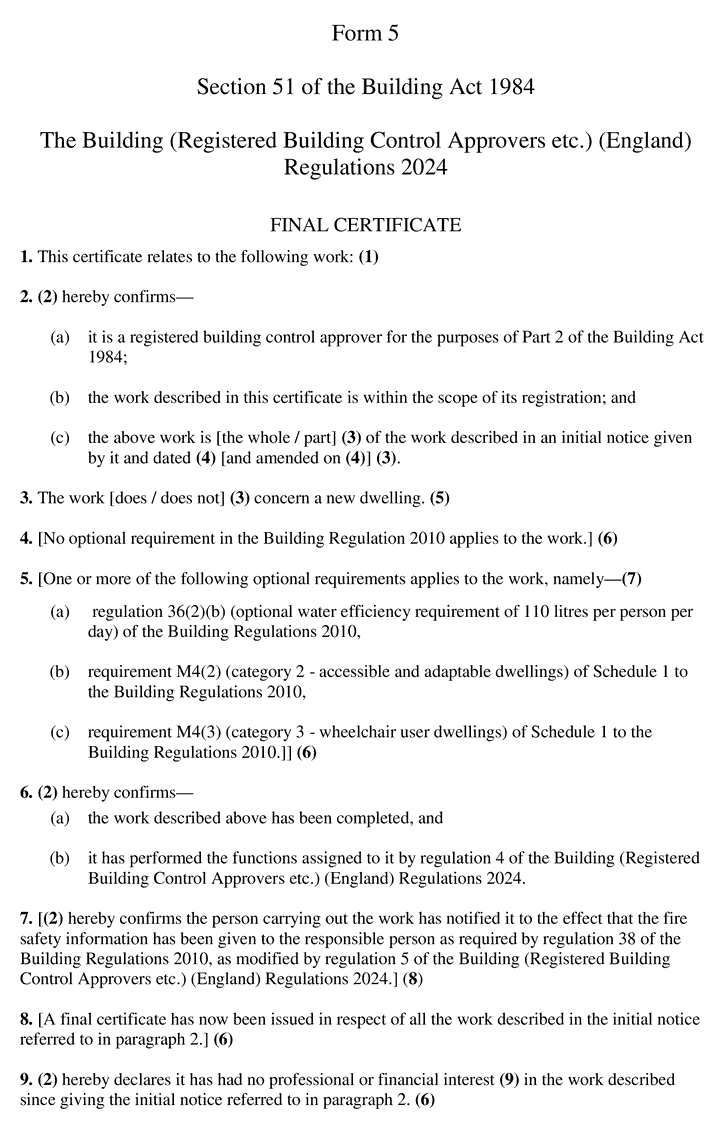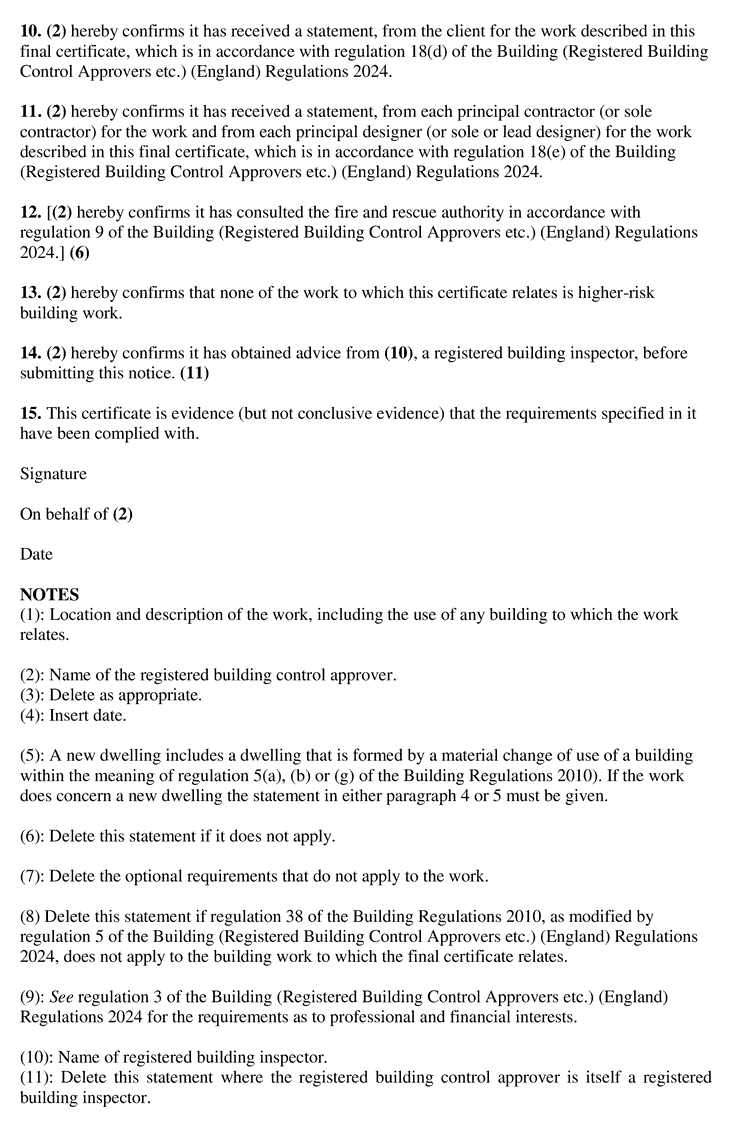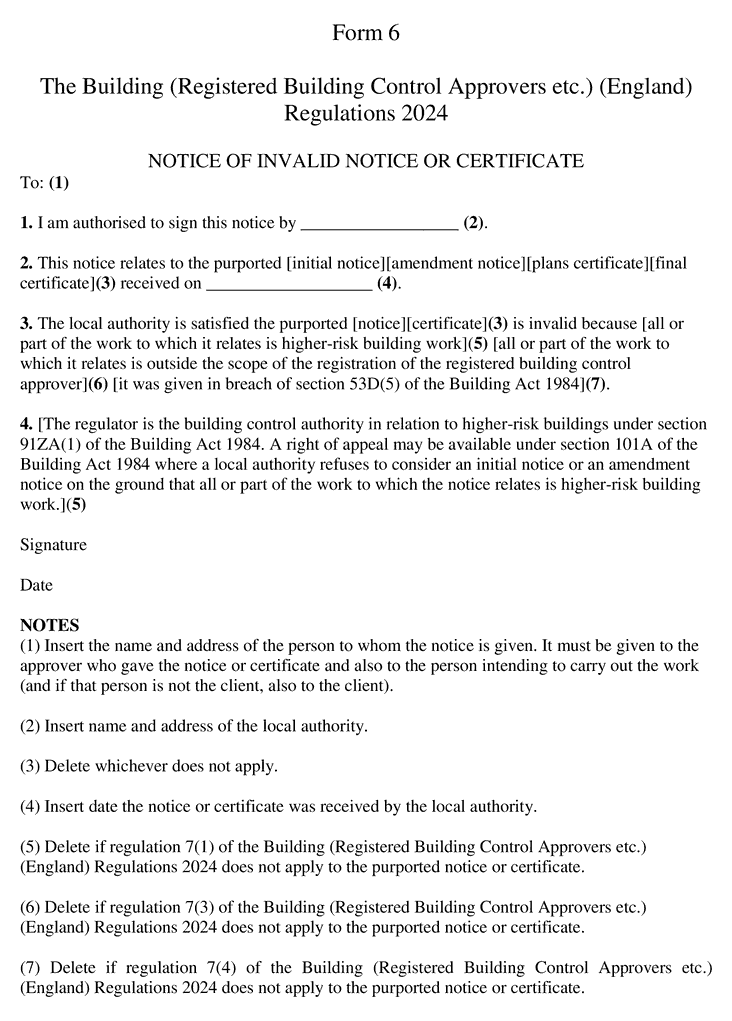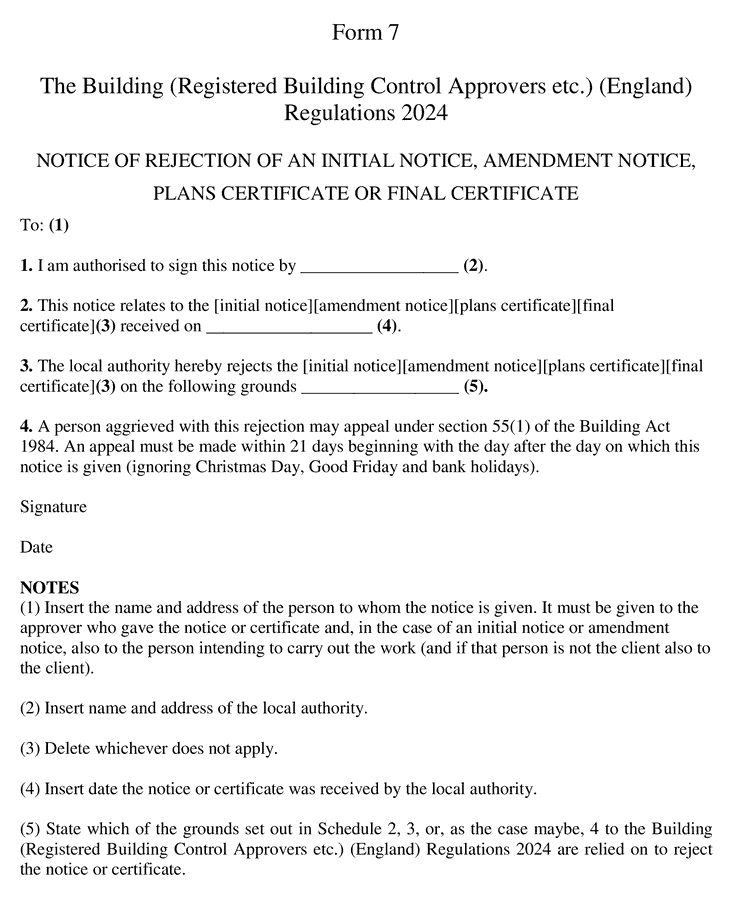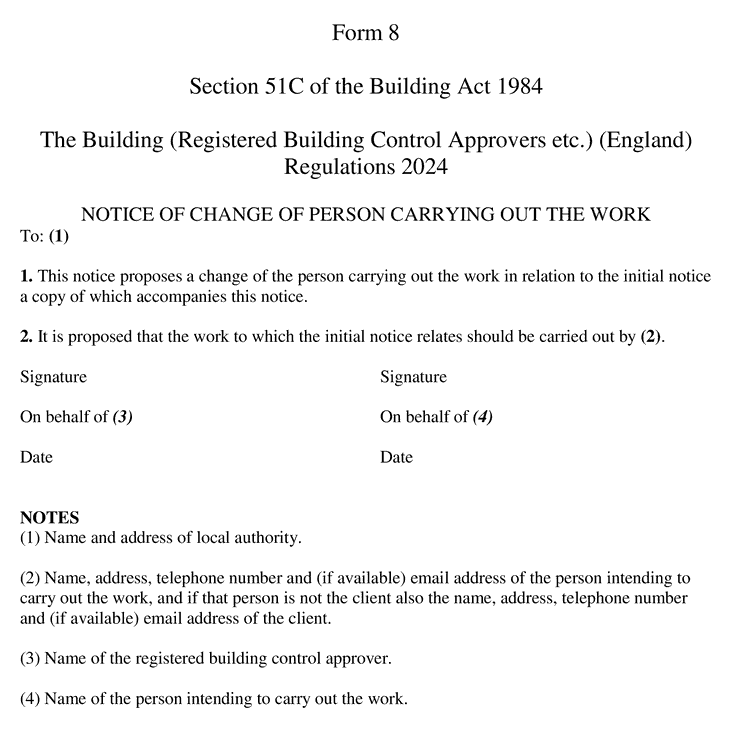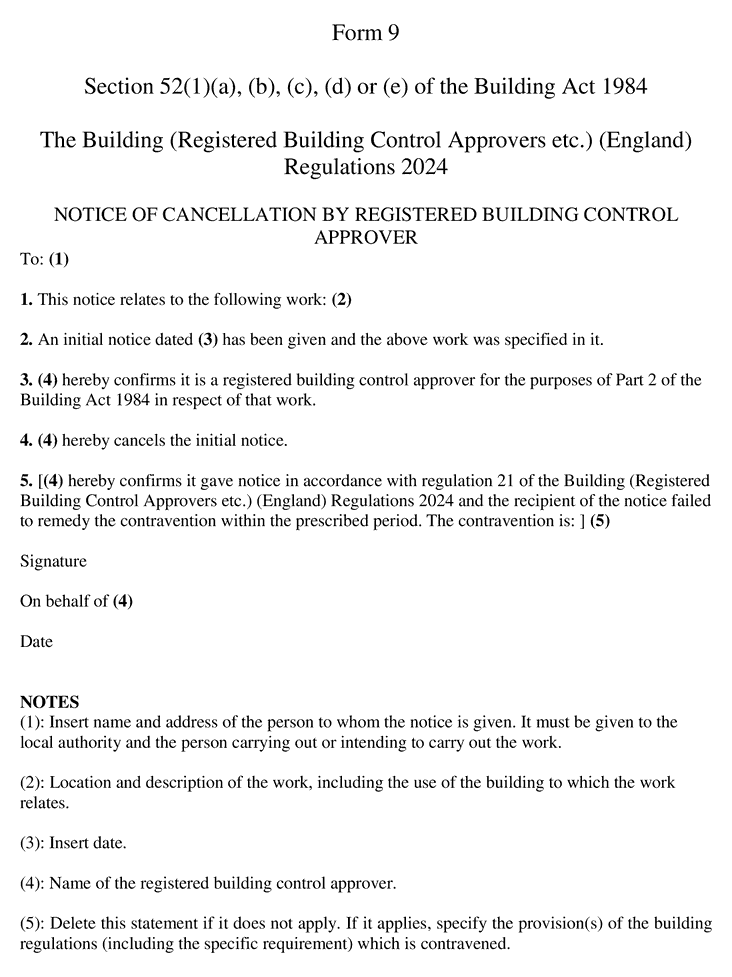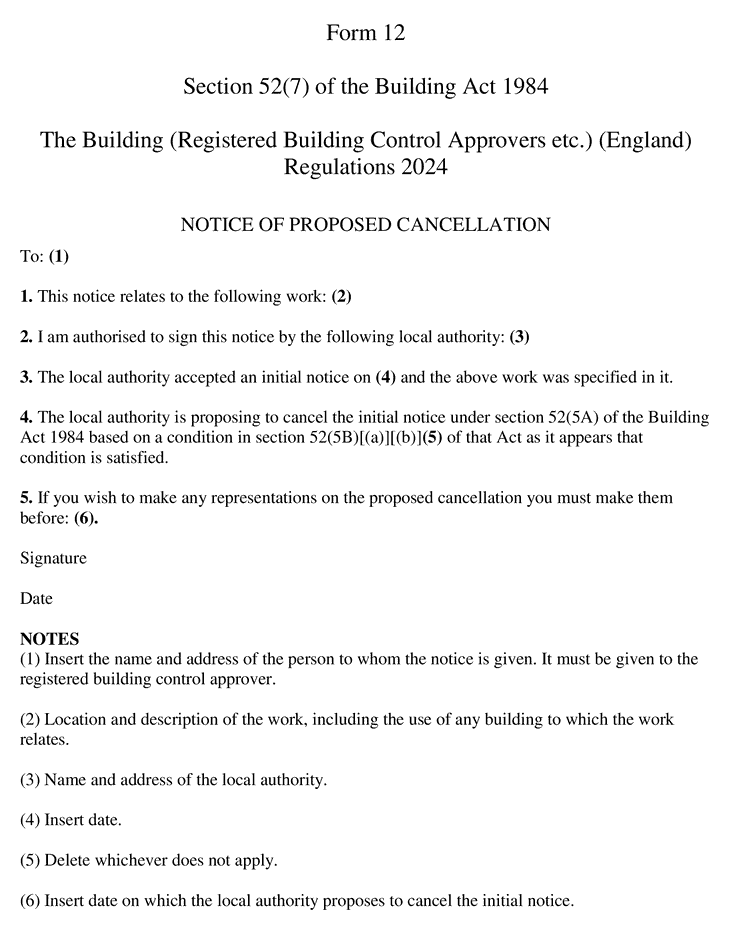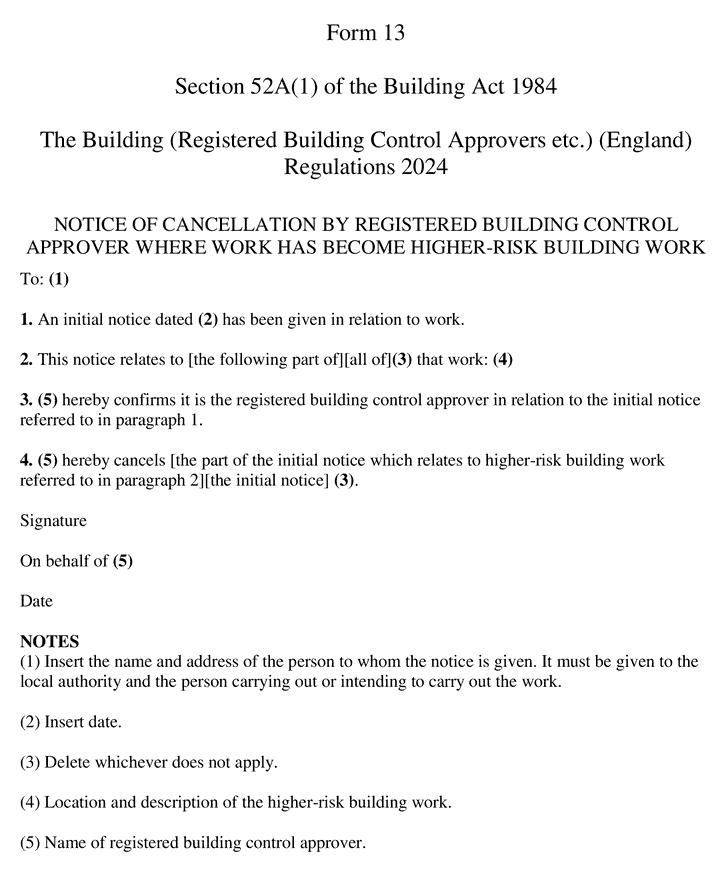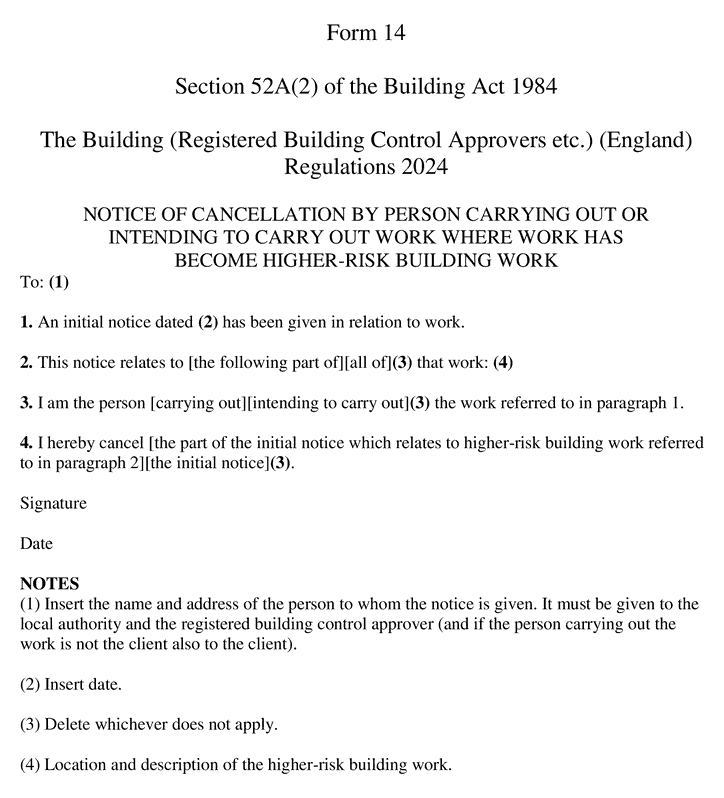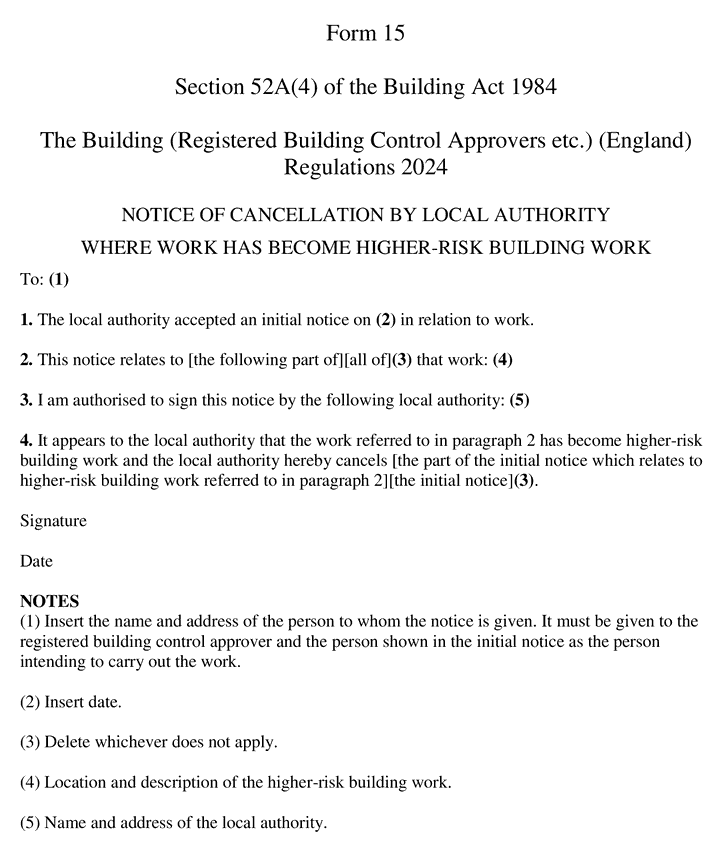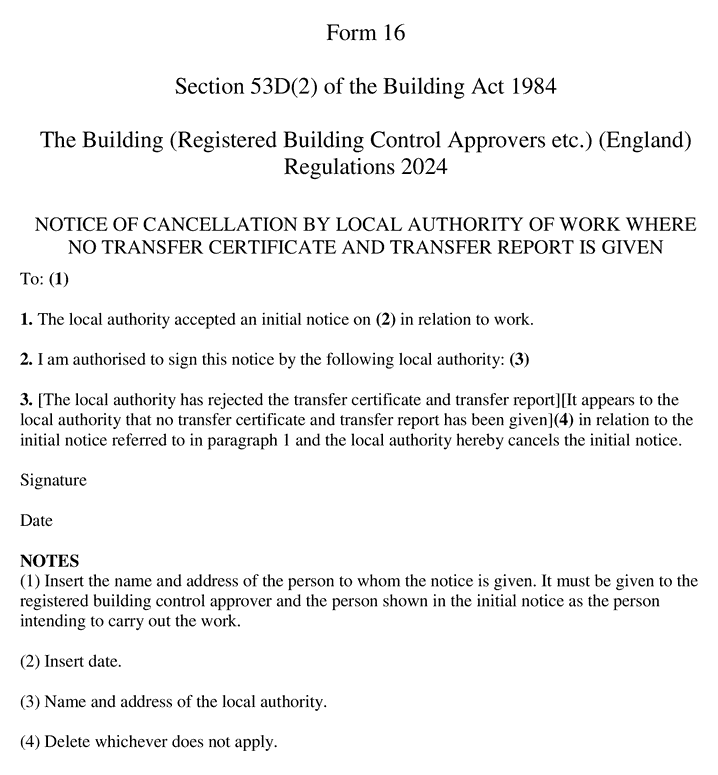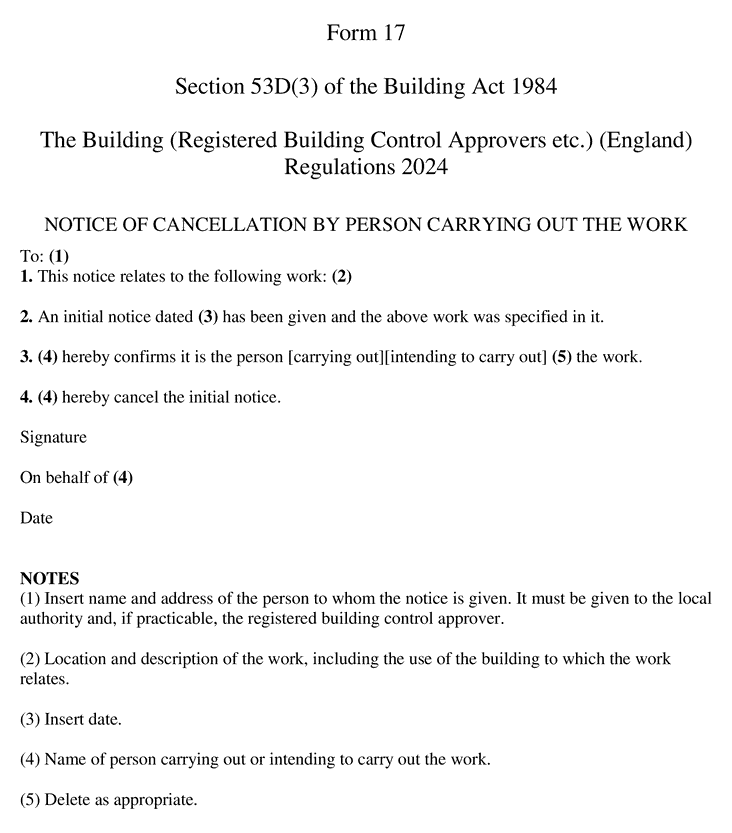- Latest available (Revised)
- Original (As made)
The Building (Registered Building Control Approvers etc.) (England) Regulations 2024
You are here:
- UK Statutory Instruments
- 2024 No. 110
- Schedules only
More Resources
Status:
This is the original version (as it was originally made).
Regulations 6, 7, 8, 11, 13, 14 and 20
SCHEDULE 1Forms
Regulations 6, 8 and 11
SCHEDULE 2Grounds for Rejecting an Initial Notice, an Amendment Notice or a Plans Certificate Combined with an Initial Notice
Form
1. The notice is not in the prescribed form.
Wrong local authority
2. No part of the work described in the notice is to be carried out in the area of the local authority to whom the notice has been given.
Capacity of approver
3. The person who signed the notice as an approver is not an approver on the date the notice is rejected or if they are an approver on that date, their registration does not include all the work described in the notice.
4. Additionally, in the case of an amendment notice, the person who signed the amendment notice as an approver is not the approver who gave the initial notice.
Breach of section 54B
5. The person specified in the notice as the registered building inspector who gave advice in relation to that notice—
(a)was not a registered building inspector on the date the notice was submitted; or
(b)was a registered building inspector on that date but their registration did not include all the work described in the notice.
Information about the proposed work
6. Neither the notice nor the accompanying plans and documents include—
(a)the location and a description of the work, including the use of any building to which the work relates;
(b)information needed by the local authority to decide whether the notice is to be rejected on ground 10 or 11;
(c)information as to whether or not the work concerns a new dwelling;
(d)a statement setting out the date when work will reach the point when it is to be regarded as commenced and, if applicable, the details of the work which the client considers amounts to 15% of the proposed work;
(e)in the case of an initial notice or an amendment notice in relation to a new dwelling, either—
(i)a statement whether or not one or more, and if so which, of the following optional requirements applies to the building work—
(aa)regulation 36(2)(b) (optional water efficiency requirement of 110 litres per person per day),
(bb)Schedule 1 Part M optional requirement M4(2) (category 2- accessible and adaptable dwellings),
(cc)Schedule 1 Part M optional requirement M4(3) (category 3- wheelchair user dwellings), or
(ii)a statement that planning permission has not yet been granted for the work, and that the information required by sub-paragraph (i) will be supplied as soon as is reasonably practicable after that permission is granted;
(f)in the case of an initial notice or amendment notice in relation to the erection of a new dwelling—
(i)a statement giving details of any public electronic communications network in relation to which a connection is to be provided;
(ii)if an exemption in regulation 44ZB of the 2010 Regulations is proposed to be relied on, a statement giving details in support of the exemption;
(iii)if regulation 44ZC of those Regulations is proposed to be relied on, a statement giving details of the matters mentioned in regulation 44ZC(6)(a) and (b) of those Regulations and, if paragraph RA1(1)(c)(i) or (ii) of Schedule 1 to those Regulations is also proposed to be relied on, evidence of the steps taken to establish whether, and if so where, a distribution point for a gigabit-capable public electronic communications network (as defined in regulation 44C of those Regulations) is likely to be installed, in a location relevant for the purposes of paragraph RA1(1)(c) of that Schedule, within the period of two years beginning with the day on which the notice is given;
(g)in the case of a plans certificate combined with an initial notice, a statement in accordance with sub-paragraph (e)(i).
Fire and rescue authority
7. The approver is obliged by regulation 9 to consult the fire and rescue authority before giving a plans certificate or final certificate, and the notice does not contain an undertaking to do so.
Sewerage undertaker
8. The approver is obliged by regulation 10 to consult the sewerage undertaker before giving a plans certificate or final certificate, and the notice does not contain an undertaking to do so.
Independence
9. The notice does not contain a declaration by the approver that the approver does not, and while the initial notice is in force will not, have any professional or financial interest in that work.
Drain connection
10. In the case of the erection or extension of a building, the local authority considers that, in order to comply with the requirements of Part H of Schedule 1 to the 2010 Regulations, a proposed drain or private sewer must discharge to an existing sewer, but the statement accompanying the notice does not describe such an arrangement.
Local enactments
11. The local authority is not satisfied that the work described will comply with any local enactment which requires or authorises them to reject an application for building control approval submitted in accordance with building regulations.
Commencement of work
12. Where a statement setting out the details of the work which the client considers amounts to 15% of all the work described in the notice has been provided, the local authority is not satisfied that the work described in the statement amounts to 15% of all the work described in the notice.
Earlier notice
13.—(1) Except where sub-paragraph (2) applies, an initial notice (“an earlier notice”) has already been given in respect of any part of the work described in the notice.
(2) The ground in sub-paragraph (1) does not apply if—
(a)an earlier notice has ceased to be in force and the local authority has taken no positive step to supervise the work described in it; or
(b)the notice is accompanied by an undertaking by the approver who gave an earlier notice to the effect that the approver will cancel that notice as soon as the initial notice under consideration is accepted.
Regulation 11
SCHEDULE 3Grounds for rejecting a plans certificate or plans certificate combined with an initial notice
Form
1. The certificate is not in the prescribed form.
Wrong building control authority
2. No part of the work described in the plans certificate is to be carried out in the area of the local authority to whom the certificate has been given.
Work
3. The certificate does not describe the work to which it relates.
Optional requirements
4. The certificate does not contain—
(a)information whether or not the work concerns a new dwelling; or
(b)in the case of a new dwelling, information whether or not one or more, and if so which, of the following optional requirements applies to the building work—
(i)regulation 36(2)(b) (optional water efficiency requirement of 110 litres per person per day),
(ii)Schedule 1 Part M optional requirement M4(2) (category 2- accessible and adaptable dwellings),
(iii)Schedule 1 Part M optional requirement M4(3) (category 3- wheelchair user dwellings); or
(c)in the case of a plans certificate relating to a new dwelling, a statement that it relates only to such part of the work to which no requirement under regulation 36 of, or requirements M4(1), (2) or (3) of Schedule 1 to, the Building Regulations 2010 may apply.
Plans
5. The certificate does not specify the plans to which it relates.
No initial notice
6. Except where the plans certificate is combined with an initial notice, no initial notice was in force with respect to the work described in the certificate at the time the certificate was given.
Capacity of approver
7. An initial notice was in force with respect to the work described in the certificate at the time the certificate was given, but—
(a)the certificate is not signed by the approver who gave the initial notice,
(b)the person who signed the certificate is not an approver on the date the notice is rejected, or
(c)where they are an approver, their registration does not include all the work described in the certificate.
Breach of section 54B
8. The person specified in the certificate as the registered building inspector who gave advice in relation to that certificate—
(a)was not a registered building inspector on the date the certificate was submitted, or
(b)was a registered building inspector on that date but their registration did not include all the work described in the certificate.
Fire and rescue authority
9. The approver was obliged by regulation 9 to consult the fire and rescue authority before giving the certificate, but the certificate does not contain a declaration that the approver has consulted them in accordance with that regulation.
Sewerage undertaker
10. The approver was obliged by regulation 10 to consult the sewerage undertaker before giving the certificate, but the certificate does not contain a declaration that the approver has consulted them in accordance with that regulation.
Independence
11. The certificate does not contain a declaration by the approver that the approver has not since giving the initial notice in question had any professional or financial interest in that work.
Regulation 13
SCHEDULE 4Grounds for rejecting a final certificate
Form
1. The certificate is not in the prescribed form.
Wrong building control authority
2. No part of the work described in the final certificate was carried out in the area of the local authority to whom the certificate has been given.
Work
3. The certificate does not describe the work to which it relates.
Optional requirements
4. The certificate does not contain information—
(a)whether or not the work concerns a new dwelling; or
(b)in the case of a new dwelling, information whether or not one or more, and if so which, of the following optional requirements applies to the building work—
(i)regulation 36(2)(b) (optional water efficiency requirement of 110 litres per person per day),
(ii)Schedule 1 Part M optional requirement M4(2) (category 2- accessible and adaptable dwellings),
(iii)Schedule 1 Part M optional requirement M4(3) (category 3- wheelchair user dwellings).
No initial notice
5. No initial notice was in force with respect to the work described in the certificate at the time the certificate was given.
No plans certificate
6. The work described in the final certificate relates to an FSO building and no plans certificate was given with respect to the work.
Capacity of approver
7. An initial notice was in force with respect to the work described in the certificate at the time the certificate was given, but—
(a)the certificate is not signed by the approver who gave the initial notice,
(b)the person who signed the certificate is not an approver on the date the certificate is rejected, or
(c)where they are an approver, their registration does not include all the work described in the certificate.
Breach of section 54B
8. The person specified in the certificate as the registered building inspector who gave advice in relation to that certificate—
(a)was not a registered building inspector on the date the certificate was submitted, or
(b)was a registered building inspector on that date but their registration did not include all the work described in the certificate.
Lack of fire safety information confirmation
9. Regulation 38 of the Building Regulations 2010, as modified by regulation 5 (modifications of the 2010 Regulations), applies to the building work to which the final certificate relates and the approver has not provided a confirmation that the person carrying out the work has notified the approver to the effect that the fire safety information has been given to the responsible person as required by that regulation.
Independence
10. The certificate does not contain a declaration by the approver that the approver has not since giving that notice had any professional or financial interest in that work.
Regulation 26
SCHEDULE 5Grounds for rejecting a transfer certificate and transfer report
Required information
1. The transfer certificate does not include the information required by regulation 25 (information to be included in transfer certificates).
Wrong local authority
2. No part of the unfinished work described in the transfer certificate is to be carried out in the area of the local authority to whom the transfer certificate has been given.
No initial notice
3. No new initial notice under section 53(7)(a) of the 1984 Act was in force with respect to the work described in the transfer certificate at the time the transfer certificate was given.
Capacity of approver
4. A new initial notice was in force with respect to the unfinished work described in the transfer certificate at the time the certificate was given, but—
(a)the certificate is not signed by the approver who gave the new initial notice,
(b)the person who signed the certificate is not an approver on the date the certificate is rejected, or
(c)where they are an approver, their registration does not include all the work described in the certificate.
Breach of section 54B
5. The person specified in the certificate as the registered building inspector who gave advice in relation to that certificate—
(a)was not a registered building inspector on the date the certificate was submitted; or
(b)was a registered building inspector on that date but their registration did not include all the work described in the certificate.
Earlier notice
6.—(1) Except where sub-paragraph (2) applies, a new initial notice under section 53(7)(a) of the 1984 Act (“an earlier notice”) has already been given in respect of any part of the unfinished work described in the notice.
(2) The ground in sub-paragraph (1) does not apply if—
(a)an earlier notice has ceased to be in force and the local authority has taken no positive step to supervise the work described in it, or
(b)the notice is accompanied by an undertaking by the approver who gave an earlier notice to the effect that the approver will cancel that notice as soon as the initial notice under consideration is accepted.
Local authority action
7.—(1) The local authority has given a section 36 notice, a compliance notice or a stop notice in relation to the unfinished work(1).
(2) The local authority received an application in relation to the whole or part of the unfinished work in accordance with regulation 18 of the 2010 Regulations.
(3) The local authority has otherwise taken any positive step to supervise the unfinished work.
Failure to provide information requested
8. The approver has been given a request under section 53C(4) of the 1984 Act but failed to provide the information within the period referred to in that section.
See sections 35B(2), 35C(3) and 36(4) of the Building Act 1984 for definitions of “compliance notice”, “stop notice” and “section 36 notice” and section 53B(9) of the Building Act 1984 for the definition of “unfinished work”.
Options/Help
Print Options
PrintThe Whole Instrument
PrintThe Schedules only
Legislation is available in different versions:
Latest Available (revised):The latest available updated version of the legislation incorporating changes made by subsequent legislation and applied by our editorial team. Changes we have not yet applied to the text, can be found in the ‘Changes to Legislation’ area.
Original (As Enacted or Made): The original version of the legislation as it stood when it was enacted or made. No changes have been applied to the text.
Explanatory Memorandum
Explanatory Memorandum sets out a brief statement of the purpose of a Statutory Instrument and provides information about its policy objective and policy implications. They aim to make the Statutory Instrument accessible to readers who are not legally qualified and accompany any Statutory Instrument or Draft Statutory Instrument laid before Parliament from June 2004 onwards.
More Resources
Access essential accompanying documents and information for this legislation item from this tab. Dependent on the legislation item being viewed this may include:
- the original print PDF of the as enacted version that was used for the print copy
- lists of changes made by and/or affecting this legislation item
- confers power and blanket amendment details
- all formats of all associated documents
- correction slips
- links to related legislation and further information resources
Impact Assessments
Impact Assessments generally accompany all UK Government interventions of a regulatory nature that affect the private sector, civil society organisations and public services. They apply regardless of whether the regulation originates from a domestic or international source and can accompany primary (Acts etc) and secondary legislation (SIs). An Impact Assessment allows those with an interest in the policy area to understand:
- Why the government is proposing to intervene;
- The main options the government is considering, and which one is preferred;
- How and to what extent new policies may impact on them; and,
- The estimated costs and benefits of proposed measures.
More Resources
Use this menu to access essential accompanying documents and information for this legislation item. Dependent on the legislation item being viewed this may include:
- the original print PDF of the as made version that was used for the print copy
- correction slips
Click 'View More' or select 'More Resources' tab for additional information including:
- lists of changes made by and/or affecting this legislation item
- confers power and blanket amendment details
- all formats of all associated documents
- links to related legislation and further information resources

